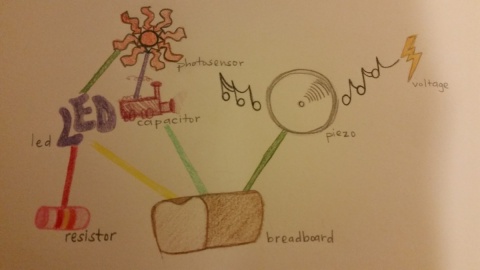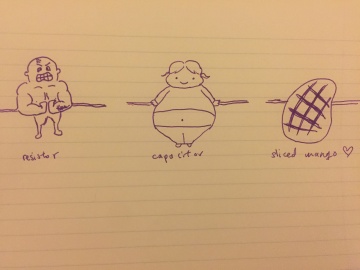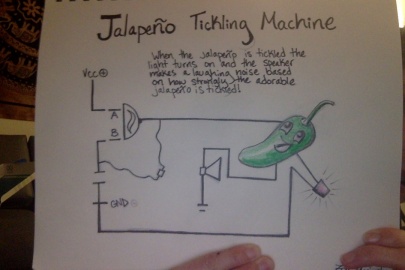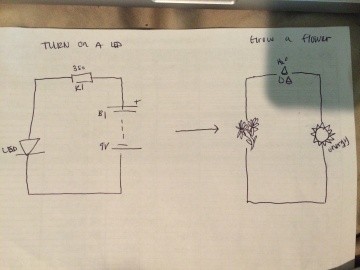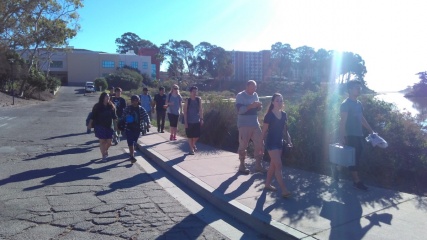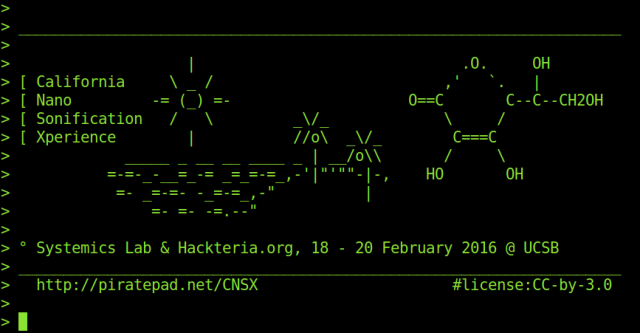LabHacking - From DIY lab tools to field-works, UCSB
Starting to put down some notes....
Contents
- 1 Mentors
- 2 Schedule
- 2.1 Week 1 - Interface Landscapes
- 2.2 Week 2 - World of Light
- 2.3 Week 3 & 4 - Sensing and Activating
- 2.4 1, 3 Feb - Week 5 - Intro BioElectronix
- 2.5 8, 10 Feb - Week 6 - Interfacing Nature I
- 2.6 17 Feb - Week 7 - Interfacing Nature II
- 2.7 22, 24 Feb - Week 8 - Interfacing Landscape Showcase
- 2.8 29, 2 Mar - Week 9 - Project Works
- 2.9 7, 9 Mar - Week 10 - Project Presentations
- 3 Special Events
- 4 Related projects on the wiki
- 5 Some movies...
- 6 How to set up the lab
- 7 Related readings
- 7.1 Home Made Bio Electronic Arts Do-it-yourself: Microscopes, Sensors, Sonifications - Christoph Merian Verlag / Migros-Kulturprozent: Dominik Landwehr, Verena Kuni (Ed.), 2013
- 7.2 Field_Notes – From Landscape to Laboratory – Maisemasta Laboratorioon, Finnish Society of Bioart, 2013
- 7.3 Hacking the Wild - Making Sense of Nature in the Madagascar Jungle
- 7.4 New Art/Science Affinities|New Art/Science Affinities
- 7.5 more...
- 8 Some links and thoughts
Mentors
Marko Peljhan - Systemics Lab
http://www.arts.ucsb.edu/peljhan/
https://www.mat.ucsb.edu/faculty.php
Marc Dusseiller - dusjagr labs / hackteria
http://www.dusseiller.ch/cv/short_bio_dusseiller15.pdf
Dr. Marc R. Dusseiller is a transdisciplinary scholar, lecturer for micro- and nanotechnology, cultural facilitator and artist. He performs DIY (do-it-yourself) workshops in lo-fi electronics and synths, hardware hacking for citizen science and DIY microscopy. He was co-organizing Dock18, Room for Mediacultures, diy* festival (Zürich, Switzerland), KIBLIX 2011 (Maribor, Slovenia), workshops for artists, schools and children as the former president (2008-12) of the Swiss Mechatronic Art Society, SGMK. In collaboration with Kapelica Gallery, he has started the BioTehna Lab in Ljubljana (2012 - 2013), an open platform for interdisciplinary and artistic research on life sciences. Currently, he is developing means to perform bio- and nanotechnology research and dissemination, Hackteria | Open Source Biological Art, in a DIY / DIWO fashion in kitchens, ateliers and in developing countries. He was the co-organizer of the different editions of HackteriaLab 2010 - 2014 Zürich, Romainmotier, Bangalore and Yogyakarta.
Other invited guests
- Scott Beibin
- Leslie Garcia & Paloma Lopez
- (Megan Daalder)
- (Andrew Quitmeyer)
Schedule
See details on Gouchospace
Week 1 - Interface Landscapes
Week 2 - World of Light
Week 3 & 4 - Sensing and Activating
1, 3 Feb - Week 5 - Intro BioElectronix
Exercise on fictional and speculative schematics
8, 10 Feb - Week 6 - Interfacing Nature I
'Playing with 4093 Oscillators'Bold text
Impressions from the Field Trip "Hacking the Beach"
17 Feb - Week 7 - Interfacing Nature II
22, 24 Feb - Week 8 - Interfacing Landscape Showcase
29, 2 Mar - Week 9 - Project Works
7, 9 Mar - Week 10 - Project Presentations
Special Events
8 Feb - ESSB Lecture - dusjagr on Smart Coconuts
http://www.mat.ucsb.edu/seminar/#marc
See the slides on slideshare "Dusseiller on Hackteria - MAT seminar, UCSB"
CNSX – California Nano Sonification Xperience, 18-20 Feb 2016
See more on http://hackteria.org/workshops/cnsx/
Related projects on the wiki
Some movies...
How to set up the lab
- Lab Making | The Book: HackteriaLab 2014 - Yogyakarta, by Urs Gaudenz, Sachiko Hirosue
"Making a Laboratory is both a spontaneous activity and a slow labor of love."
A Lab is a place to labor (not only of love), experiment, research and share - there is no labor, experiment, research or sharing without the people. A Lab is not a museum for journalists, but a place made by a person for other people Start a small Lab , put it in a box, suitcase, backpack, picnic basket and take it with you. A Mobile Lab it actually allows you to go to people, and not wait for the others to come.
- Lab Infrastructure / Equipment
Experiences from setting up the BioTehna Lab Infrastructure. People not equipment. 20% Science 80% Rock'n'Roll.
Materials list: here
- Making Laboratories at COOP 2016, Trento
The Making Laboratories is a two day seminar focusing on the topic of Workshopology. In it, experts from different fields of research and practice – from academia to fablabs – will team up in order to co-create both guidelines for workshops and physical prototypes of educational activities, collaboratively discussed, designed and prototyped in the FabLab facility.
- Designing for Tinkerability has some great ideas about tinkering with space and variety of materials
- Temporary Autonomous Labs TALs
Background / Inspirations for Systemic Integration
Related readings
Home Made Bio Electronic Arts Do-it-yourself: Microscopes, Sensors, Sonifications - Christoph Merian Verlag / Migros-Kulturprozent: Dominik Landwehr, Verena Kuni (Ed.), 2013
http://hackteria.org/2013/05/23/home-made-bio-electronic-arts-published/
After 2 years of discussions with various people in the field of DIYbio, hackteria and BioArt, Dominik Landwehr and Verena Kuni published a new book in their HomeMade series. This time with the title “Home Made Bio Electronic Arts” they go some steps closer to interfacing the living world with DIY tinkering and electronics, easy accessible instructions for everybody. Additionally some editorial essays and an interview with Gerfried Stocker. A production by Migros-Kulturprozent with the Christoph Merian Verlag.
- Six easy do-it-yourself experimental projects
- For biotechnology and electronics do-it-yourself enthusiasts
“Science for all” is the motto of a new movement which deals with biology and electronics. It applies the do-it-yourself approach, well established in the electronic and computer scene, to natural sciences. Here the boundaries between the arts and sciences are fluid. The artists and scientists who work together in an interdisciplinary manner call themselves “bio-hackers” or “bio-punks” and deliberately continue in the creative tradition of those two movements. Their research is designed to communicate scientific insights which are otherwise reserved for scientists. Home Made Bio Electronic Arts introduces leading exponents and presents six easy do-it-yourself experimental projects.
The Chapter about the DIY microscope can be downloaded here. And available now with Chinese translation included! Thanks to I-Chern Lai and Dimension+! Download it here
See other selected chapters of the Book: Homemade Biological Art for download.
Field_Notes – From Landscape to Laboratory – Maisemasta Laboratorioon, Finnish Society of Bioart, 2013
http://bioartsociety.fi/Field_Notes_Teaser.pdf
Every second year the Finnish Society of Bioart invites a significant group of artists and scientists to the Kilpisjärvi Biological Station in Lapland/Finland to work for one week on topics related to art, biology and the environment. “Field_Notes – From Landscape to Laboratory” is the first in a series of publications originating from this field laboratory. It emphasizes the process of interaction between fieldwork, locality and the laboratory. Oron Catts, Antero Kare, Laura Beloff, Tarja Knuuttila amongst others explore the field and laboratory as sites for art&science practices.
BETWEEN LANDSCAPE AND LABORATORY
How to define the evolving field of art&science, including bioart, and where can the historical trajectory of this area within the arts be found? In very general terms one could divide currently existing artistic interests in the field into two very broad subject categories: artists that are concerned with the environment, and artists whose work focuses on the human as subject matter. The previous group deals with environment, landscape, natural phenomena, plants, and animals typically in their natural habitat. The latter group is interested in the human as such and within his technologically augmented environment. This includes work with human enhancement and organs, with devices and manipulation of human and animal cells. The work is carried out either under laboratory conditions or with technologically mediated social structures including human and non-human actors. Shared aspects across the field are e.g. politics, ethical debates and projections of the possible futures. This publication is specifically focusing on work that is concerned with the environment and ecology. However, the human is strongly present in all the arguments, statements and accounts. It is very apparent that we live in the era of the anthropocene, where viewpoints and actions are unavoidably developed with and projected from a human perspective.
The publication is edited by Laura Beloff, Erich Berger and Terike Haapoja. It is bilingual in Finnish and English and contains 17 articles and additional material of Finnish and international contributors. You can buy the book now from our website: http://bioartsociety.fi/books
Hacking the Wild - Making Sense of Nature in the Madagascar Jungle
http://www.blurb.com/b/6264498-hacking-the-wild
http://andy.dorkfort.com/andy/digitalnatural/category/pubs/print/
New Art/Science Affinities|New Art/Science Affinities
- New Art/Science Affinities free for download. Please read through it briefly and select one article/project that inspires you and present it during the introduction round with a few sentences, what it is and why it inspired you.
more...
Some links and thoughts
Related Field / Landscape and Art Programs
Fielworks and bio+art, Saul Nava


